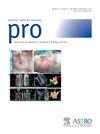脑转移瘤立体定向放射手术后切缘扩张对局部控制和放射性坏死的影响:一项系统回顾和荟萃分析。
IF 3.5
3区 医学
Q2 ONCOLOGY
引用次数: 0
摘要
目的:在使用立体定向放射手术(SRS)治疗脑转移瘤时,边缘扩大对局部控制(LC)和放射性坏死(RN)的影响仍不清楚。我们进行了一项系统综述和荟萃分析,比较了计划采用无边缘与有边缘立体定向放射手术(SRS)治疗脑转移瘤患者的局部控制率和放射性坏死率:我们采用PICOS/PRISMA/MOOSE选择纳入标准,对接受无边缘或有边缘SRS治疗的脑转移患者进行研究。主要结果为1年生存率、放射学和症状性RN发生率。为了比较效应大小,我们进行了加权随机效应荟萃分析:在17项研究中,我们发现了5015个病灶接受了SRS治疗(1360个病灶无边缘,3684个病灶有边缘)。总边缘中位数为 1.5 毫米(范围:1-3)。单部分 SRS 最为常见,中位处方剂量为 21 Gy(范围:15-24 Gy)。有边缘(88.4% (95% CI: 83.7-92.4%) 与无边缘(83.0% (95% CI: 69.3-93.2%; p = 0.28))的估计 1 年 LC 率相似。无边缘 SRS 与有边缘 SRS 后放射学 RN 的估计发生率相似,分别为 9.2% (95% CI: 0.2-29.6%) 和 7.0% (95% CI: 4.1-10.7%; p=0.56)。无边缘SRS与有边缘SRS后无症状RN的估计发生率分别为8.6%(95% CI:5.2-12.7%)和4.1%(95% CI:0.9-9.3%)(P=0.24):采用扩大边缘治疗与不采用扩大边缘治疗的患者在LC或RN方面均无显著差异。有必要进行前瞻性评估,在控制其他相关治疗计划和转移因素的同时,进一步评估这一问题。本文章由计算机程序翻译,如有差异,请以英文原文为准。
The Impact of Margin Expansions on Local Control and Radionecrosis Following Stereotactic Radiosurgery for Brain Metastases: A Systematic Review and Meta-Analysis
Purpose
The implications of margin expansions on local control (LC) and radionecrosis (RN) for treating brain metastases (BMs) with stereotactic radiosurgery (SRS) remain unclear. We performed a systematic review and meta-analysis to compare LC and RN between patients with BMs treated with SRS planned with no margin versus a margin.
Methods and Materials
We used the Population, Intervention, Control, Outcomes, Study Design; the Preferred Reporting Items for Systematic Reviews; and Meta-analyses, and the Meta-analysis of Observational Studies in Epidemiology selection inclusion criteria for studies of patients with BMs treated with SRS with no margin or a margin. Primary outcomes were 1-year LC and radiographic and symptomatic RN incidences. Weighted random effects meta-analyses were performed to compare effect sizes.
Results
Across 17 studies, we identified 5015 lesions treated with SRS (1360 lesions with no margin and 3684 with a margin). The median total margin was 1.5 (range, 1-3) mm. Single-fraction SRS was most common with a median prescription dose of 21 Gy (range, 15-24 Gy). The estimated 1-year LC rate was similar with a margin (88.4% [95% CI, 83.7%-92.4%]) versus without (83.0% [95% CI, 69.3-93.2%; P = 0.28]). The estimated incidences of radiographic RN after SRS with or without a margin were 9.2% (95% CI, 0.2%-29.6%) and 7.0% (95% CI, 4.1%-10.7%; P = 0.56), respectively. The estimated incidences of symptomatic RN after SRS without or with a margin were 8.6% (95% CI, 5.2%-12.7%) and 4.1% (95% CI, 0.9%-9.3%), respectively (P = .24).
Conclusions
We did not note a significant difference in LC or RN between patients treated with or without margin expansions. Prospective evaluations are warranted to further assess this question while controlling for other relevant treatment planning and metastasis considerations.
求助全文
通过发布文献求助,成功后即可免费获取论文全文。
去求助
来源期刊

Practical Radiation Oncology
Medicine-Radiology, Nuclear Medicine and Imaging
CiteScore
5.20
自引率
6.10%
发文量
177
审稿时长
34 days
期刊介绍:
The overarching mission of Practical Radiation Oncology is to improve the quality of radiation oncology practice. PRO''s purpose is to document the state of current practice, providing background for those in training and continuing education for practitioners, through discussion and illustration of new techniques, evaluation of current practices, and publication of case reports. PRO strives to provide its readers content that emphasizes knowledge "with a purpose." The content of PRO includes:
Original articles focusing on patient safety, quality measurement, or quality improvement initiatives
Original articles focusing on imaging, contouring, target delineation, simulation, treatment planning, immobilization, organ motion, and other practical issues
ASTRO guidelines, position papers, and consensus statements
Essays that highlight enriching personal experiences in caring for cancer patients and their families.
 求助内容:
求助内容: 应助结果提醒方式:
应助结果提醒方式:


